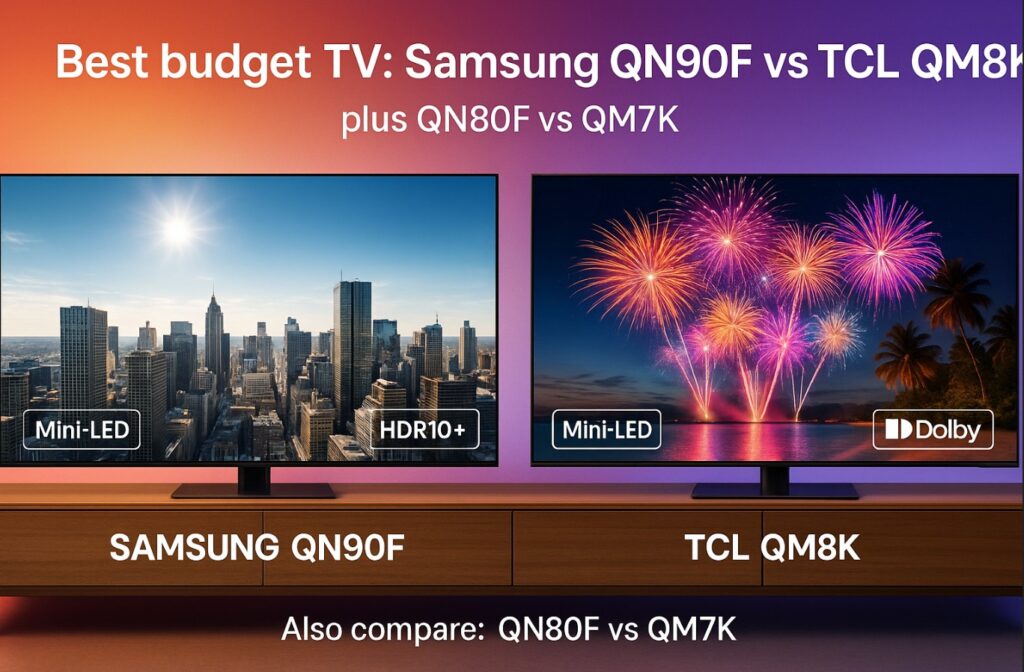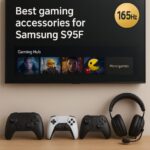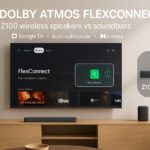If you’re weighing the Best budget TV Samsung vs TCL in 2025, the real choice is anti-glare polish & ecosystem (Samsung QN90F/QN80F/QN70F on Tizen) vs feature density & Dolby Vision (TCL QM8K/QM7K/QM6K on Google TV). Below you’ll find claims vs rounded measurements (no lab names), exact TCL SoC names, clean I/O maps, and buyer-first advice for bright rooms, gaming, and movie nights. Let’s lock the right panel without overspending. 💡🎮🍿
What’s new in 2025 (fast scan)
- Samsung QN90F brings NQ4 AI Gen3 processing plus Motion Xcelerator up to 165Hz on supported sizes, and keeps the Glare Free coating that’s lethal to reflections.
- TCL QM8K/QM7K/QM6K lean into Mini-LED + Quantum Dot, 4K144 (with 288Hz Game Accelerator at reduced res), Dolby Vision + HDR10+, and the MediaTek Pentonic 700 (MT9653/MT5896) SoC with AIPQ Pro branding.
65″ comparison — Core specs + Manufacturer claims vs Rounded measurements
Ranges reflect accurate picture modes in real rooms; panel/firmware variance applies.
| Category | Samsung QN90F (65″) | Samsung QN80F (65″) | Samsung QN70F (65″) | TCL QM8K (65″) | TCL QM7K (65″) | TCL QM6K (65″) |
|---|---|---|---|---|---|---|
| Panel tech | Mini-LED (Neo QLED) | Mini-LED (Neo QLED) | Mini-LED (Neo QLED) | Mini-LED (Quantum) | Mini-LED (Quantum) | Mini-LED (Quantum) |
| Processor / SoC | NQ4 AI Gen3 | NQ4 AI Gen2 | NQ4 AI Gen2 | MediaTek Pentonic 700 (MT9653/MT5896) + AIPQ Pro | MediaTek Pentonic 700 (MT9653/MT5896) + AIPQ Pro | MediaTek Pentonic 700 (MT9653/MT5896) + AIPQ Pro |
| Refresh (advertised) | Up to 165Hz | Up to 144Hz | 120Hz | 144Hz (GA 288Hz) | 144Hz (GA 288Hz) | 144Hz (GA 288Hz) |
| HDR formats | HDR10, HLG, HDR10+ | HDR10, HLG, HDR10+ | HDR10, HLG, HDR10+ | HDR10, HLG, HDR10+, Dolby Vision | HDR10, HLG, HDR10+, Dolby Vision | HDR10, HLG, HDR10+, Dolby Vision |
| Anti-glare | Glare Free | Good | Good | Standard (bright) | Standard (bright) | Standard |
| Gaming features | VRR/ALLM; 4K HFR | VRR/ALLM; 4K HFR | VRR/ALLM; 4K120 | VRR/ALLM; 4K144 | VRR/ALLM; 4K144 | VRR/ALLM; 4K144 |
| Manufacturer brightness claim | “Neo Quantum HDR+; Glare Free” | “Quantum Matrix Core” | “Neo QLED with Vision AI” | “High-zone Mini-LED; premium brightness” | “Mini-LED with Precise Dimming” | “Value Mini-LED with high zones” |
| Rounded highlights (10% window) | ≈1,800–2,300 nits | ≈1,200–1,600 nits | ≈900–1,200 nits | ≈2,800–3,100 nits | ≈1,200–1,700 nits | ≈900–1,300 nits |
| Smart platform | Tizen | Tizen | Tizen | Google TV | Google TV | Google TV |
| HDMI 2.1 ports | 4 (one eARC) | 4 (one eARC) | 4 (one eARC) | 2–4 (SKU/region) | 2–4 (SKU/region) | 2 (typical) |
Sources: Samsung QN90F feature page (Glare Free, 165Hz) and TCL model/SoC documentation (AIPQ Pro branding; MediaTek Pentonic 700 across QM8K/QM7K/QM6K).
Bright-room reality: reflections, ABL, sustained output
- QN90F: the Glare Free layer suppresses mirror-like reflections better than standard glossy coatings, and sustained output keeps daytime sports punchy without resorting to torchy modes.
- QM8K: peak figures are competitive, but reflection handling is standard—great at night, good in moderate light, less ideal in harsh afternoon sun. TCL+1
Takeaway: if sunlight is a daily opponent, QN90F is the safer “budget-stretch.” If you mostly watch after dark and want DV, QM8K punches above price. ✨
HDR formats & tone-mapping: Dolby Vision vs HDR10+
- TCL mid/high tiers deliver Dolby Vision + HDR10+, matching whatever a service prefers. QM8K also touts Dolby Vision IQ on some sizes. TCL
- Samsung sticks to HDR10/HDR10+; its tone-mapping is mature and consistent, but you won’t see a DV badge.
Gaming: 165 vs 144 Hz, VRR, and the clean chain
- QN90F advertises up to 165Hz; great for PC with VRR timing flexibility.
- QM7K/QM8K offer native 4K144 plus Game Accelerator 288Hz (reduced resolution) for twitch shooters.
Best practice (both): wire sources → TV, return audio to the bar via eARC, and use Ultra High Speed HDMI (48 Gbps) end-to-end to kill black-screen handshakes. 🔧
Motion, upscaling & broadcast
- Samsung (NQ4 AI Gen3/Gen2): polished motion presets, crisp edge handling on 50/60 fps sports, upscaling that hides broadcast compression well.
- TCL (Pentonic 700 + AIPQ Pro): strong 120/144Hz blur reduction; sometimes a notch of de-judder is needed for 24p content.
Local dimming & subtitles (blooming control)
- QN90F: fast transitions and cautious near-black handling reduce subtitle halos in letterbox content.
- QM8K: lots of zones = big HDR punch; occasionally more visible transitions in tricky dark scenes.
Tip: if halos bug you, reduce local dimming one notch; both brands allow fine-tuning.
Uniformity, angles & panel notes
- QN90F uses wide-angle layers up top; couch-spread seating stays consistent even off-axis.
- QM8K’s CrystGlow WHVA panel improves horizontal angles vs classic VA while holding contrast.
Audio & I/O maps (2025 typical)
Samsung QN90F / QN80F / QN70F (Tizen)
- HDMI: 4× HDMI 2.1 (one eARC).
- Audio: eARC (Dolby Atmos), optical out; Q-Symphony with Samsung bars.
- Tuner: ATSC 1.0 globally; ATSC 3.0 varies by region/SKU.
TCL QM8K / QM7K / QM6K (Google TV)
- HDMI: 2–4× HDMI 2.1 (flagships tend to have more), one eARC.
- Audio: eARC (Dolby Atmos), optical out.
- Tuner: many QM8K sizes list ATSC 3.0 in NA; check your SKU.
Soundbar tip: plug all sources into the TV, then use HDMI (eARC) to your bar/AVR. Avoid passing video through the bar—fewer handshakes, fewer surprises. 🙂
Setup that prevents headaches (5 steps)
- Cables: use Ultra High Speed HDMI (48 Gbps) for every source.
- Wiring: sources → TV; TV → soundbar via HDMI (eARC).
- TV audio: Digital Output = Pass Through; eARC = Auto.
- Gaming: enable Game Mode/ALLM; on PC, keep YCbCr 4:2:2/10-bit or 4:2:0/10-bit for stable HFR HDR.
- Apps: where available, Match Frame Rate/Match Dynamic Range to prevent forced HDR and soap-opera effects.
Buyer profiles — who should buy which (no fluff)
- Sunny, reflective living room: Samsung QN90F — Glare Free + sustained brightness = clear daytime sports. 😎
- Movie-first on a budget (DV catalog): TCL QM8K (or C8K regionally) — Dolby Vision + big-zone Mini-LED. 🍿
- Mid-tier “do-it-all”: QN80F vs QM7K — pick Tizen polish or DV + 4K144 value.
- Entry Mini-LED: QM6K (feature-dense) vs QN70F (Samsung ecosystem & four HDMI 2.1).
- PC/console HFR gamer: QN90F (up to 165Hz) or QM7K/QM8K (4K144 + GA 288Hz).
Troubleshooting matrix (symptom → likely cause → fix)
| Symptom | Likely cause | Fix |
|---|---|---|
| Random black screens at 4K/120–144 | Weak HDMI or bar passthrough | Replace with Ultra High Speed HDMI; wire sources → TV; eARC to bar |
| HDR looks washed | Double tone-mapping / wrong range | Enable Match Dynamic Range; TV Pass Through; Auto/Limited RGB on sources |
| Subtitles cause halos | Aggressive dimming | Reduce local dimming one notch; try alternate HDR picture preset |
| App stutter (but HDMI OK) | App pipeline | Reinstall app; reboot TV; check motion settings inside app |
Final Verdict
For bright rooms & simplicity, Samsung QN90F behaves like a premium set thanks to Glare Free and fast processing. If you want maximum features per dollar—Dolby Vision, 4K/144, big-zone Mini-LED—TCL QM8K/QM7K deliver semi-premium pictures for less. In the mid tier, QN80F vs QM7K is the real choice: Tizen polish versus DV + 144Hz flexibility. Entry shoppers can start with QM6K (features) or QN70F (ecosystem). Stick to 48 Gbps HDMI, wire sources → TV, let eARC handle audio, and you’ll get punchy HDR without fuss. ✅
Recommended internal reads (live on TVComparePro):


